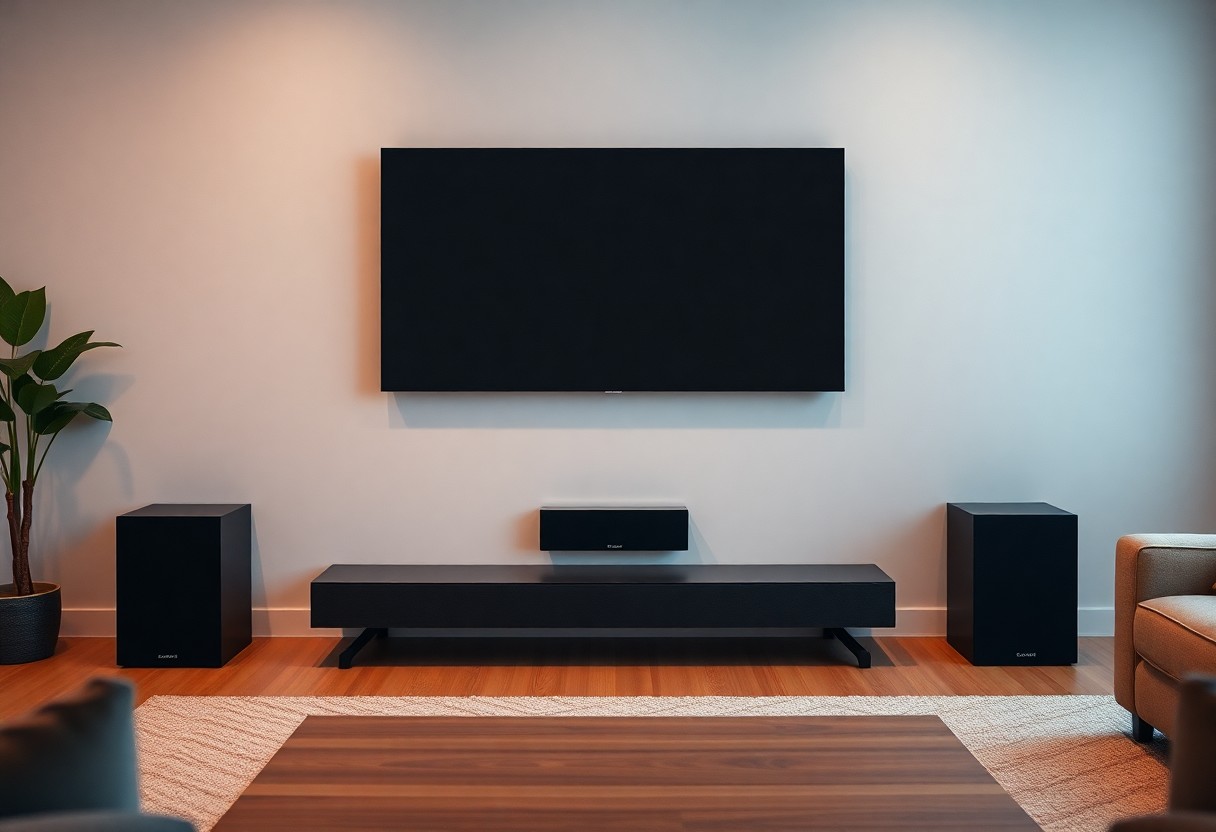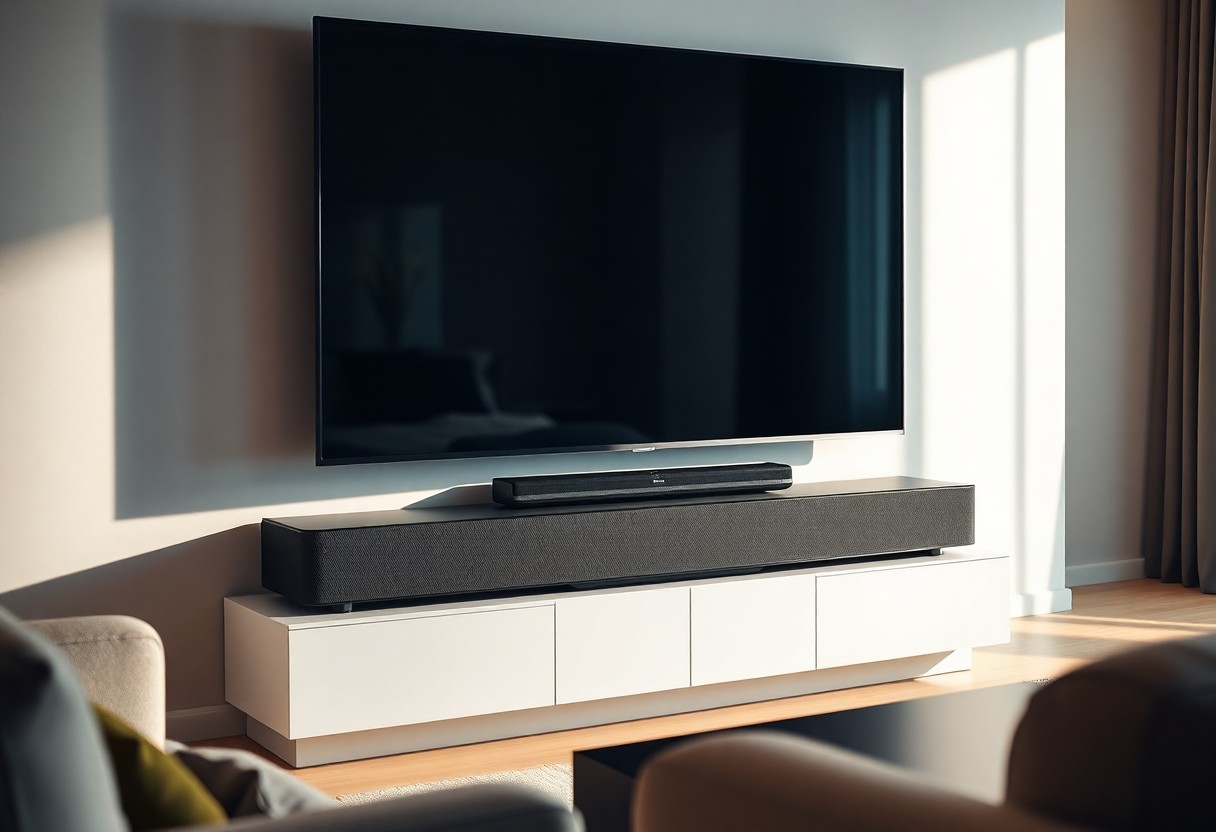Many people find setting up a soundbar to be a daunting task, but it doesn’t have to be! In this guide, you’ll learn how to effortlessly connect your stylish soundbar to enhance your audio experience in just a few easy steps. With straightforward instructions designed for any skill level, you’ll be enjoying rich, immersive sound in no time. Get ready to transform your home entertainment system with this simple setup process that will have your music and movies sounding their best.
Contents
- Understanding Your Soundbar
- Key Features to Look For
- Different Types of Soundbars
- How to Choose the Right Soundbar
- Factors to Consider
- Compatibility with Your TV
- Setting Up Your Soundbar
- Step-by-Step Installation Guide
- Wiring and Connections
- Tips for Optimal Sound Quality
- Positioning Your Soundbar
- Adjusting Audio Settings
- Troubleshooting Common Issues
- Connectivity Problems
- Sound Quality Concerns
- Maintaining Your Soundbar
- Cleaning Tips
- Software Updates
- Summing up
Understanding Your Soundbar
As you commence on your soundbar journey, it’s vital to understand its features, types, and functionalities. A soundbar enhances your audio experience with sleek design and powerful sound without the clutter of traditional speaker setups. Getting familiar with these aspects will ensure you make the best choice and enjoy immersive sound quality.
Key Features to Look For
On your quest to find the ideal soundbar, consider the following key features:
- Audio Quality: Look for high fidelity sound and clarity.
- Connectivity Options: Ensure it has HDMI, Bluetooth, or Wi-Fi capabilities.
- Built-in Subwoofer: Offers deeper bass without needing extra components.
- Virtual Surround Sound: For a more immersive listening experience.
- Size & Design: Match it aesthetically with your home setup.
Knowing these features will empower you to choose a soundbar that fits your audio needs perfectly.
Different Types of Soundbars
This section will guide you through the various types of soundbars available in the market:
- Soundbars with Subwoofers: Provide powerful bass and richer sound.
- Slim Soundbars: Perfect for smaller spaces and minimalistic designs.
- Wireless Soundbars: Eliminate cable clutter and allow for flexible placement.
- Smart Soundbars: Integrated with voice assistants for smart home integration.
- Multi-Room Sound Systems: Allow audio streaming across different rooms.
Knowing the differences among these types will help you select the one that best accommodates your lifestyle and audio preferences.
An in-depth understanding of different soundbar types can significantly influence your decision. Exploring each type’s characteristics helps you weigh the pros and cons effectively, ensuring you find the right fit for your needs.
- Soundbars with Surround Sound: Mimic surround sound for cinematic experiences.
- Soundbars with Adjustable Sound Profiles: Customize audio settings exceptional to a genre.
- Soundbars with DTS and Dolby Atmos: Enhanced sound formats for immersive listening.
- Portable Soundbars: Easy to transport and use in various settings.
- Soundbars with HDMI ARC: Simplifies connectivity and control with a single cable.
Knowing these additional features can enhance your overall experience, ensuring that your soundbar setup is both functional and enjoyable.
| Type of Soundbar | Description |
|---|---|
| Soundbars with Subwoofers | Deliver robust bass for action movies and music. |
| Slim Soundbars | Space-saving options for a tidy look. |
| Wireless Soundbars | Flexible placement choices eliminate cables. |
| Smart Soundbars | Integrate seamlessly with voice-controlled devices. |
| Multi-Room Systems | Connects soundbars throughout your home for consistent audio. |

How to Choose the Right Soundbar
The right soundbar can elevate your home audio experience, but choosing one requires careful consideration. Consider your room size, budget, and the types of media you enjoy. A well-selected soundbar will not only enhance your TV watching but also provide immersive audio for your favorite tunes and games.
Factors to Consider
Clearly, you should evaluate several factors before making your choice. Think about the following:
- Room size and acoustics
- Wattage and sound output
- Features like Dolby Atmos and Bluetooth
- Design and aesthetics
This can lead you to the perfect fit for your audio needs.
Compatibility with Your TV
Now, ensuring your soundbar is compatible with your TV is necessary for a seamless setup. Check the connection options available, such as HDMI ARC, optical, or Bluetooth, to guarantee connectivity. Additionally, confirm the soundbar supports your TV’s audio formats to enhance the overall sound experience.
Your soundbar’s compatibility with your TV not only affects the audio quality but also the user experience. Some soundbars come equipped with HDMI ARC, allowing for easier control through a single remote. Others might utilize optical cables, which can deliver great sound but may not support advanced audio formats. By matching the connectivity options and features of your soundbar with your TV’s specifications, you’ll create a harmonious audio-visual experience that enhances your entertainment setup.
Setting Up Your Soundbar
Now that you have your stylish soundbar ready, it’s time to set it up for an immersive audio experience. Follow the simple steps to get your soundbar up and running in no time. Whether you’re a tech novice or a seasoned pro, you’ll find that setting up your soundbar is a breeze with this guide.
Step-by-Step Installation Guide
You can easily follow this installation guide to get your soundbar ready:
| Step | Description |
| 1 | Locate the optimal position for the soundbar beneath your TV. |
| 2 | Connect the power cable to the soundbar and plug it into an outlet. |
| 3 | Use an HDMI or optical cable to connect your soundbar to the TV. |
| 4 | Turn on your soundbar and TV, then select the correct input source. |
Wiring and Connections
With the right wiring and connections, your soundbar will deliver exceptional sound quality. Connecting your soundbar is straightforward, as most models offer multiple options such as HDMI ARC, optical, and auxiliary connections. Choose the method that suits your setup best for optimal performance.
For instance, if you use the HDMI ARC connection, it enables you to control the soundbar and TV with a single remote. However, if your TV lacks this feature, using an optical cable is a reliable alternative. Ensure that all cables are securely connected to avoid any disruptions in audio quality, and double-check your TV settings to confirm the soundbar is recognized as the preferred audio output. Happy listening!

Tips for Optimal Sound Quality
Not all soundbars are created equal, and making adjustments can significantly enhance your listening experience. Here are some tips to ensure you achieve the best sound quality:
- Position your soundbar at ear level when seated.
- Ensure there are no obstructions blocking the speakers.
- Experiment with different sound modes for movies, music, and games.
- Keep the firmware updated for the latest performance enhancements.
After making these adjustments, you should notice a remarkable improvement in sound clarity and depth.
Positioning Your Soundbar
For optimal audio output, place your soundbar centered directly beneath your TV. Ensure its height allows the sound to reach ear level when you’re seated. Additionally, avoid placing it inside a cabinet or too close to walls, as this can affect the sound dispersion and overall balance.
Adjusting Audio Settings
Tips for fine-tuning your soundbar settings include accessing the equalizer and adjusting bass, treble, and dialogue levels. This will allow you to tailor the audio output according to your preferences and the content you’re enjoying.
Your soundbar’s audio settings are important for optimizing performance based on what you watch or listen to. Start by adjusting the equalizer to enhance the bass or treble according to your taste. Many soundbars offer various presets for movies, music, or gaming, making it easier to switch modes depending on your activity. Don’t hesitate to experiment with different settings until you find the ideal sound profile that suits your environment and preferences.
Troubleshooting Common Issues
To ensure you have an uninterrupted audio experience, it’s important to troubleshoot common issues that may arise with your soundbar. Whether you’re encountering connectivity challenges or sound quality concerns, knowing how to address these problems will let you enjoy your soundbar to the fullest without frustration.
Connectivity Problems
With various devices often vying for your soundbar’s attention, connectivity problems can occur. If your soundbar isn’t syncing with your TV or streaming device, try power cycling them or ensuring that your cables are securely connected. Check that you’re on the correct input source and that Bluetooth settings are activated if you’re using a wireless connection.
Sound Quality Concerns
Little adjustments can make a world of difference when it comes to sound quality. If you’re facing issues like distorted audio or low volume, consider checking any equalizer settings on your soundbar and adjusting the bass and treble. Also, ensure that your soundbar isn’t placed in a corner or surrounded by obstacles that could impede sound flow.
Another effective approach is to troubleshoot audio delay, which might cause lip-sync issues. Look for a “lip-sync” or “audio delay” setting in your soundbar’s menu and adjust it to match the video. In some cases, disconnecting and reconnecting your soundbar can reset any audio settings that may have altered. Regularly updating firmware can also resolve persistent sound quality troubles, so keep that in mind as you enjoy your soundbar.
Maintaining Your Soundbar
After you’ve set up your soundbar, it’s important to keep it in excellent condition. Routine maintenance will ensure that you enjoy high-quality audio for years to come. For tips on how to fully maximize your soundbar experience, check out this Complete Guide to Setting up a Soundbar.
Cleaning Tips
Clearly, keeping your soundbar clean is important for optimal performance. To maintain its appearance and functionality, follow these tips:
- Dust the exterior regularly with a soft, lint-free cloth.
- Avoid using harsh chemicals or abrasive materials.
- Ensure the vents are clear to prevent overheating.
The quality of sound can be affected by accumulated dust and dirt.
Software Updates
Maintaining your soundbar’s software is equally important for ensuring seamless performance and access to the latest features. Frequent updates can enhance connectivity and audio quality.
Your soundbar may have a built-in update feature, often found in the settings menu. Additionally, consider checking the manufacturer’s website for any available firmware updates that can improve functionality and fix any potential issues. Keeping your device updated can provide a smoother user experience.
Summing up
Now that you have a streamlined guide for effortlessly setting up your stylish soundbar in minutes, you can enhance your audio experience with ease. By following the simple steps outlined, you’ll be able to connect your soundbar to your devices and enjoy superior sound quality without any hassle. Embrace the convenience and elevate your entertainment setup to the next level, allowing you to immerse yourself in your favorite shows and music like never before.

Leave a Reply